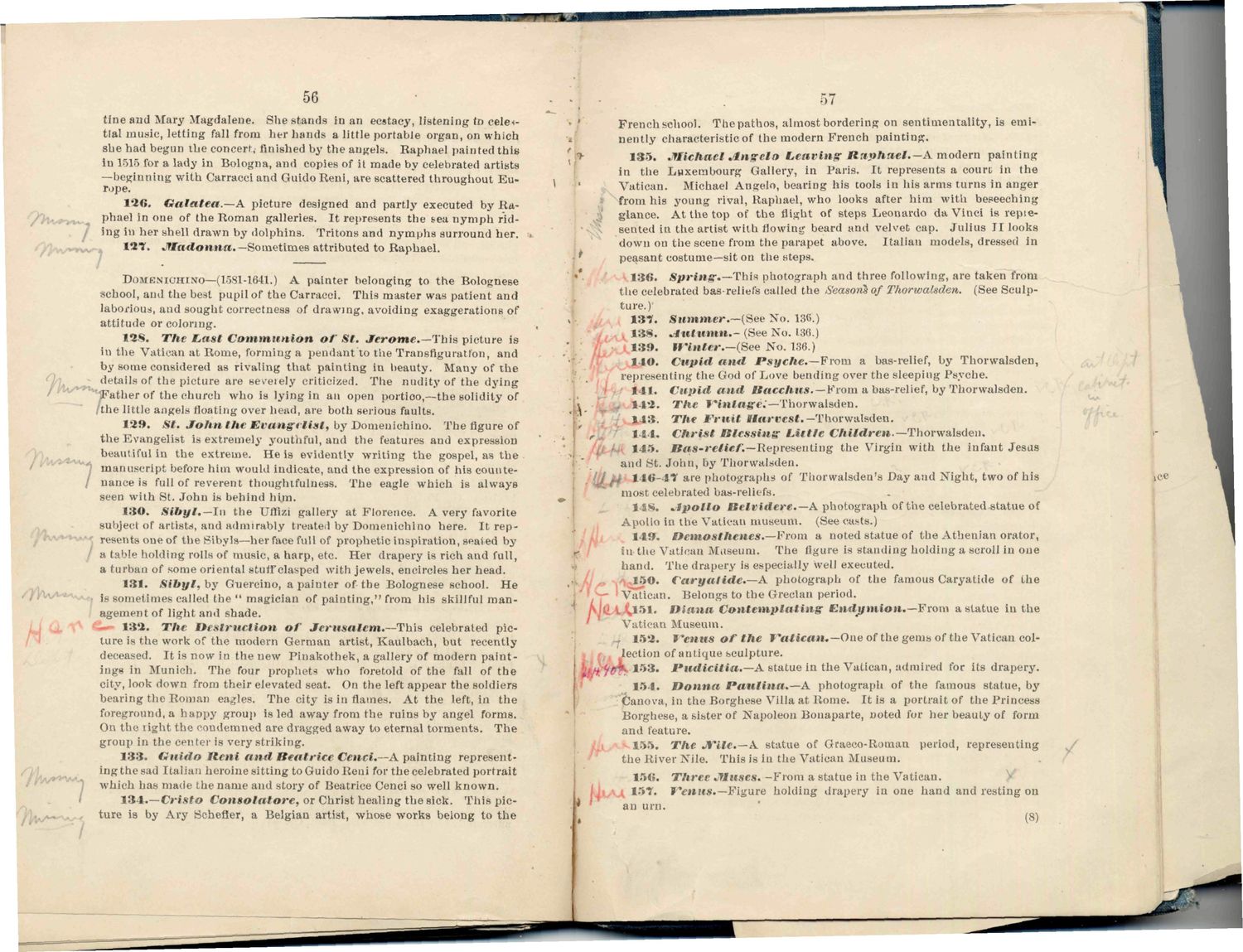| |
| |
Caption: Book - Gregory Art Collection Catalog (Gregory)
This is a reduced-resolution page image for fast online browsing.

EXTRACTED TEXT FROM PAGE:
56 tine and Mary Magdalene. She stands in an ecstacy, listening in celestial music, letting fall from her hands a little portable organ, on which she had begun ihe concert, finished by the angels. Raphael painted this iu 1516 for a lady in Bologna, and copies of it made by celebrated artists —beginning with Carracci and GuidoReni, are scattered throughout Europe. l'i(i. Galatea.—A picture designed and partly executed by Raphael in one of the Roman galleries. I t represents the sea nymph riding in her shell drawn by dolphins. Tritons and nymphs surround her. 127. JTIadonna.—Sometimes attributed to Raphael. DOMENIOHINO—(1581-1641.) A painter belonging to the Bolognese school, and the best pupil of the Carracci. This master was patient and laborious, and sought correctness of drawing, avoiding exaggerations of attitude or coloring. 12S. The Last Communion of St. Jerome.— This picture is In the Vatican at Rome, forming a pendant to the Transfiguration, and by some considered as rivaling that painting in beauty. Many of the details of the picture are seveiely criticized. The nudity of the dying //kt/~*H 'IFather of the church who is lying in an open portioo,—the solidity of /the little angels floating over head, are both serious faults. 1 2 9 . St. John the Evangelist, by Domeniohino. The figure of the Evangelist is extremely youthful, and the features and expression beauiifuliu the extreme. He is evidently writing the gospel, as the manuscript before him would indicate, and the expression of his eounte/ nance is full of reverent thouglufulness. The eagle which is always seen with St. John is behind him. ISO. Sibyl.—In the Uffizi gallery at Florence. A very favorite subject of artists, and admirably treated by Domeniehino here. It represents one of the Sibyls—her face full of prophetic inspiration, seated by / a table holding rolls of music, a harp, etc. Her drapery is rich and full, a turban of some oriental stuff'clasped with jewels, encircles her head. 1.11. Sibyl, by Guereino, a painter of the Bolognese school. He i.- sometimes called the " magician of painting," from his skillful management of light and shade. 1 3 2 . The Destruction of Jerusalem.—This celebrated picture is the work of the modern German artist, Kaulbaeh, but recently deceased. It is now in the new Pinakothek, a gallery of modern paintings in Munich. The four prophet* who foretold of the fall of the city, look down from their elevated seat. On the left appear the soldiers bearing the Roman eagles. The city is in flames. At the left, in the foreground, a happy group is led away from the ruins by angel forms. On the right the condemned are dragged away to eternal torments. The group in the center is very striking. 1 3 3 . liuidn Heni and Beatrice Cenci.—A painting representing the sad Italian heroine sitting toGuidoReui for the celebrated portrait which has made the name and story of Beatrice Cenci so well known. 1 3 4 . — C r i s t o Consolatore, or Christ healing the sick. This pict u r e is b y A r y Scne Hvs~~ A e r i a Belgian artist, whose works belong to the 57 French school. The pathos, almost bordering on sentimentality, is eminently characteristic of the modern French painting. 1 3 5 . Michael .lngrtn Leaving Raphael.— A modern painting in the Luxembourg Gallery, in Paris. It represents a court in the Vatican. Michael Angelo, bearing his tools in his arms turns in anger from his young rival, Raphael, who looks after him with beseeching glance. At the top of the flight of steps Leonardo da Vinci is repiesented in the artist with flowing beard and velvet cap. Julius I I looks down on the scene from the parapet above. Italian models, dressed in peasant costume—sit on the steps. 13fi. Spring.—This photograph and three following, are taken from the celebrated bas-reliefs called the Seasons of Thorwalsden,. (See Sculpture.) 1 3 7 . Summer.—(See No. 136.) 188, Autumn.(See No. 136.) fZ^Xliiii. Winter.—(See No. 136.) 1 4 0 . Cupitl and Psyche.—From a bas-relief, by Thorwalsden, representing the God of Love bending over the sleeping Psyche. 111. Cupid and Bacchus. — From a bas-relief, by Thorwalsden. 1 4 2 . The Vintage:—Thorwalsden. 1 1 3 . The Fruit Harvest. —Thorwalsden. , 14 1. Christ Blessing Little Children.— Thorwalsden. 145. Bas-relief.—Representing the Virgin with the infant Jesus and St. John, by Thorwalsden. 1 1 6 - 4 7 are photographs of Thorwalsden's Day and Night, two of his most celebrated bas-reliefs. 14S. *lpollo Belvidcre.—A photograph of the celebrated statue of Apollo in the Vatican museum. (See casts.) 1 4 9 . Demosthenes.—From a noted statue of the Athenian orator, lit the Vatican M.iseuiu. The figure is standing holding a scroll in one hand. The drapery is especially well executed. 7 _ . 150. Caryalidc.—A photograph of the famous Caryatide of the Vatican. Belongs to the Grecian period. A I G A ^ 1 5 1 . Diana Contemplating Endymion.—From a statue iu the Vatican Museum. 152. fenus of the ¥*atican.—Oiie of the gems of the Vatican collection of antique sculpture. ' \ 1 5 3 . M*udicitia.—A statue in the Vatican, admired for its drapery. 1 5 4 . Donna Paulina.—A photograph of the famous statue, by Canova, in the Borghese Villa at Rome. It is a portrait of the Princess Borghese, a sister of Napoleon Bonaparte, noted for her beauty of form and feature. 155. The Jt"ile.—A statue of Graeco-Roman period, representing / the River Nile. This is in the Vatican Museum. 1JMJ. Three JtMuscs. - F r o m a statue in the Vatican. ¥ MtAA 157. femes.—Figure holding drapery in one hand and resting on an urn. («) I -' •". J
| |